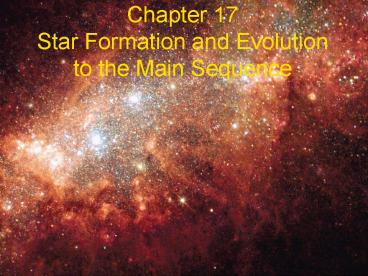Chapter 17 Star Formation and Evolution to the Main Sequence - PowerPoint PPT Presentation
1 / 40
Title:
Chapter 17 Star Formation and Evolution to the Main Sequence
Description:
Chapter 17 Star Formation and Evolution to the Main Sequence – PowerPoint PPT presentation
Number of Views:152
Avg rating:3.0/5.0
Title: Chapter 17 Star Formation and Evolution to the Main Sequence
1
Chapter 17Star Formation and Evolution to the
Main Sequence
2
Eagle Nebula
- Hydrogen (red)
- Dust clouds
- Bok Globules (smallest darkest clouds)
- Young hot stars that ionize the hydrogen
3
Molecular Hydrogen
- Extensive and non-uniform distribution of
molecular hydrogen in the plane of the Milky Way
4
Interstellar Dust Particles
- Dust is 1 of the interstellar medium
- Dust is small, like soot
5
Horsehead Nebula
- Dust against bright background of ionized hydrogen
6
Molecular Clouds
- Object Size Density
- Giant Molecule Cloud Complex 150 ly, 100
- Giant Moleculaar cloud 12 ly, 1000
- Core of molecular cloud 3, 4000
- Dark Cloud complex 30, 400
- Dark cloud 1.5 10,000
- Dark cloud core 0.6, 40,000
7
Molecular Hydrogen
- Ultraviolet spectrum of molecular hydrogen dust
grains needed for formation
8
Two Mechanisms of Cloud Collapse
- (a) Radiation pressure from nearby hot star
- (b) Collisions of colliding clouds
- Other mechanisms
- Supernova explosion blast wave
- Galaxy density waves
9
Dynamical PhaseNot to scale, subject to change
10
Mechanisms of Cloud CollapseDynamical Phase,
short time scales
- (a)Giant molecular cloud fragments into small
pieces about 100,000 AU in size - (b) Interior collapses faster making a core
- (c) Collapsing core has so much pressure, core
collapse halted - (d)Core collapse reverses direction the core
bounce - (ef) expanding core meets collapsing outer
regions then entire object collapses again - (g) Core becomes opaque, light particles not free
to escape as density is so high - (hi) collapse continues with increasing speed
until a 2nd core bounce happens increase in temp
and brightness put object on the HR diagram
11
Protostar Evolution during Dynamical Collapse
12
Approach to Main Sequence
13
From cloud to star
- (1-3) dynamical phase energy still transported
by convection, turbulent!! No visible radiation,
absorbed by dust, infrared is main observational
tool - (4) Shrinking continues, energy transport
converts from convection to radiation - (5) Core temp 10 Million K, hydrogen burning
- (6) Increase in outward pressure due to H burning
slows and eventually stops collapse, H burning
becomes dominant energy source - A STAR is born! (ZAMS -gt Zero age main sequence)
14
Events after HydrogenBurning Starts
15
Timelines
- 30 Solar masses O star, 30,000 years to reach
ZAMS - 10 Solar masses B star, 300,000 years
- 4 , B, 1,000,000 years
- 2, A, 8,000,000 years
- 1, G2, 30,000,000 years
- 0.5 K 100,000,000 years
- 0.2, M 1,000,000,000 years
16
Bipolar CO Molecular Cloud
- Radio observations
- Blue shifted and red shifted lobes
- Model to explain observations
- Note accretion disk
17
BokGlobules
- Small dark clouds associated with star formation
18
IR View of Star Formation Region
19
T Tauri Stars
- T Tauri stars in Taurus-Auriga dark cloud
- Evolutionary paths
- Birthline is the theoretical line below which
stars should appear on H-R diagram - Consistent with accretion disks around protostar
- Lots of Lithium -gt young stars Li is destroyed
at temps in MS stars
20
Stages of Star Formation for Low-Mass Star
- The predicted infrared spectrum at each stage is
shown - Varies from blackbody because of IR emission from
dust
21
Herbig-Haro Object
22
Herbig-Haro Object inside Bok Globule
23
Formation of Expanding OB Association
24
Eagle Nebula
25
Eagle Nebula molecular gas
26
Star Cluster
- Cannot observe changes in stars over time
available time scales - Clusters help us
- All are at same distance
- All formed out of same material
- All formed about the same time
27
Pleiades star Cluster
- Young stars illuminating and reflecting light
from dust in cloud through which stars are passing
28
Pleiades star Cluster
29
M92
30
M80
31
M13
32
Evolution of Imaginary Cluster
33
Star Formation in NGC 2264
- Gas, dust, molecular cloud
- T Tauri stars
- Hot, young OB stars
- Physical association of all these are consistent
with star formation ideas
34
H-R Diagram of NGC 2264
35
Brown Dwarf Gliese 229B
36
Orion Nebula
- Nebula shines because of UV radiation from hot
stars at center
37
Orion Nebula
- Optical Infrared
38
H-R Diagram for Orion
- Low-mass stars
- Theoretical lines for stars of constant age
39
Protoplanetary Disks in Orion
40
Chapter 17 HW Problems
- Summary Questions 3,4,6
- Applying Your Knowledge 5































